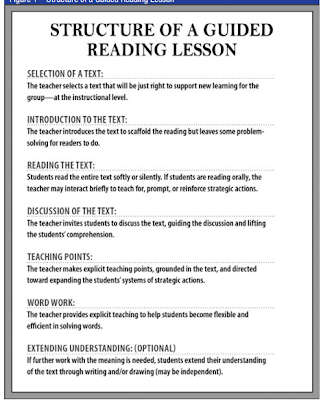Guided reading is an approach to reading instruction that
aims to teach readers tools and strategies to read better on their own. Guided
reading involves a small group, a shared text, and a teacher.
Before Reading
|
During Reading
|
After Reading
|
||
|
Teacher reminds them what they
have been talking about
Teacher has students point to
pictures
Asks questions about pictures to
activate more background knowledge and get students in the right mode of
thought
Teacher and students make
prediction
All read title out loud
All go through book page by page
discussing concepts
Teacher asks questions about text
Teacher asks questions about
students’ feelings and experiences
Teacher asks a lot of “What do you
notice?”
Connects pictures to text very
deliberately, matching pictures to words
Teacher uses text to practice
phonemic awareness
“Are there some other words that
you know?”
Students point to follow along
Teacher explains how punctuation
affects meaning
|
Students are going to read quietly
to themselves
Teacher models good reading behavior
Teacher instructs students to
re-read if they finish for more practice
Teacher goes around to each
quietly reading student and makes notes about the strategies they are using
and their progress, helps them along if they are struggling
Teacher is encouraging
|
Teacher goes over strategies the
students used and reinforces phonemic awareness techniques
Teacher reinforces comprehension
strategies
Word work—flashcards about terms
students have been discussing, teacher shows pictures and students say the
term
Phonemic awareness exercise: “what sound does this word begin with?” , students match letters to onset sounds, then to final sounds (reviews silent e) |
I really liked this video and appreciated the amount of time the teacher spent on pre-reading activities. I like that she kept the group centered and focused and made her expectations clear, especially by modeling each behavior before the students did it. I think guided reading is something I would want to make a big part of my reading instruction. It was cool to see how it worked in a lower-level setting like in this video. I wonder how it would be run for older students. The only thing I thought could be improved was allowing students more time to arrive to conclusions without prompting, giving students a bit more time to express themselves and to consider things. Question for myself: if this is something I value, how will I make it a priority in a super busy extra-packed day?
Reading A-Z seems like a cool website with a lot of good resources, although their membership is almost one hundred dollars a year.They seem to have a lot of good activities, graphic organizers, etc. and it's great how everything is divided and cross-referenced by the skill or subject you are looking to focus on. I hope someone put some of these things on Pinterest, is all I'm saying.









.JPG)
